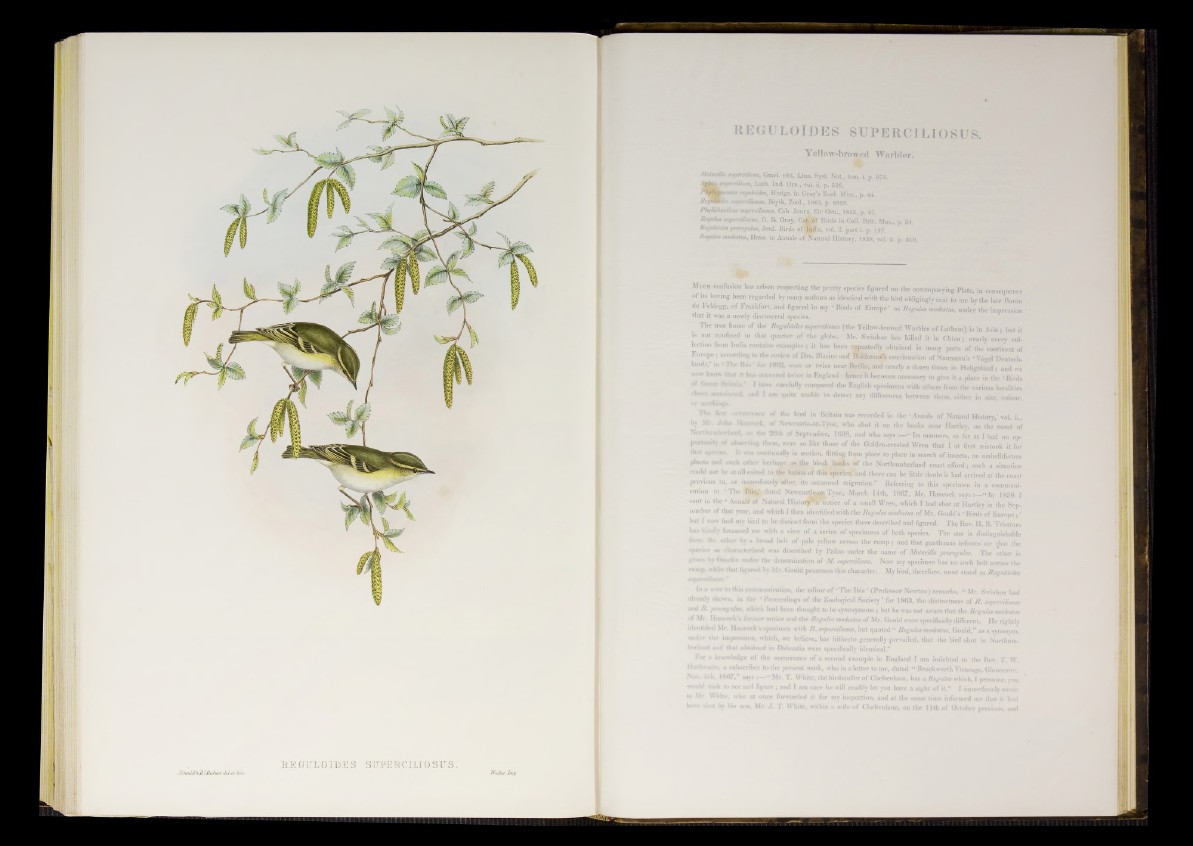
E E G U I O I B E S SEPEB.CT1 1 0 SIT S.
Walter, bnp
Yellow-browed Warbler.
MotaciUtt supercilma. Gmel. edit Linn. Syst. Nat, tom. i. p. 975.
sr'7#icUiosa, Lath. Ind. Orn., vol. ü. p. 526.
Fhy0^pr^<sts reguloides, Hodgs. in Gray’s Zool. Misc., p. 44.
RegmUe-i mpereiliosus, Blyth, Zool., 1863, p. 8329.
PhyllöbasUem superdlioans, Cab. Journ. für Orn., 1853, p. 81.
Regulus supereikosus, G. R. Gray, Cafc.qf Birds in Coll. Brit. Mus., p. 54.
Reguloides proregulus, Jerd. Birds of India, vol. ii. part i. p. "197.
Regulus modesttu, Hanc. in Annals of Natural History, 1838, vol. ii. p. 310.
Much confusion lias arisen respecting the pretty species figured on the accompanying Plate, in conseqnei.ee
o f its having been regarded by many authors as identical with the bird obligingly sent to me by the late Baron'
de Feldegg, o f Frankfort, and figured in my ■ Birds of Europe > as Regotu, modettm, under the impression
that it was a newly discovered species.
The true home of the Reguloides superciliosus (the Yellow-browed Warbler o f Latham) is in Asia; but it
is not confined to that quarter of the globe. Mr. Swinhoe has killed it in China; nearly every collection
from India contains examples; it has been repeatedly obtained in many parts of the continent of
Europe ; according to the review o f Drs. Blasius and Baldamus’s continuation of Naumann’s * Vogel Deutschland
«,’ in ‘ The Ibis ’ for 1862, once or twice near Berlin, and nearly a dozen times in Heligoland ; and we
now know that it has occurred twice in England : hence it becomes necessary to give it a place in the • Birds
of Great Beitmu/ i have carefully compared the English specimens with othere from the various localities
above mentioned, and I am quite unable to detect any differences between them, either in size, colour,
V first occurrence of the bird in Britain was recorded in the ‘ Annals of Natural History,’ vol. ii.,
John Hancock, of Newcastle-on-Tyne, who shot it on the hanks near Hartley, on the coast of
Northumberland, on the 26th of September, 1838, and who savs:—“ Its manners, so far as I had an opportunity
of observing them, were so like those of the Golden-crested Wren that I at first mistook it for
that sjiecies. It was continually in motion, flitting from place to place in search of insects, on umbelliferous
plants and such other herbage as the bleak banks of the Northumberland coast afford; such a situation
could not be at all suited to the habits o f this species, and there can be little doubt it had arrived at the coast
previous to, or immediately after, its autumnal migration.” Referring to this specimen -in a communication
to * The Ibis,’ dated Newcastle™ Tyne, March 14th, 1867, Mr. Hancock says:—“ In 1838 I
sent to the • AnnalPof Natural Histoiyv a notice of a small Wren, which I had shot at Hartley in the September
of that year, and which I then identified with the Regulus modestus of Mr. Gould’s * Birds o f Europe; ’
but I now find my bird to be distinct from the species there described and figured. The Rev. H. B. Tristram
has kindly favoured me with a view of a series of specimens of both species. The one is distinguishable
from the other by a broad belt of pale yellow across the rump; and that gentleman informs me that the
species so characterized was described by Pallas under the name of Motacilla proregulus. The other is
given bv Gindin under the denomination o f M. superdtiosa. Now my specimen has no such belt across the
rump, while that figured by Mr. Gould possesses this character. My bird, therefore, must stand as Reguloides
In a note to this communication, the editor o f ‘ The Ibis ’ (Professor Newton) remarks, “ Mr. Swinhoe had
already shown, 111 the ‘ Proceedings of the Zoological Society ’ for 1863, the distinctness of R . supercUiosus
and R . proregulus, which had been thought to be synonymous ; but he was not aware that the Regulus modestus
of Mr. Hancock’s former notice and the Regulus modestus of Mr. Gould were specifically different. He rightly
identified Mr. Hancock’s specimen with R . superciliosus, but quoted “ Regulus modestus, Gould,” as a synonym,
under the impression, which, we believe, has hitherto generally prevailed, that the bird shot in Northumberland
and that obtained in Dalmatia were specifically identical.”
ro r a knowledge of the occnrrence of a second example in England I am indebted to the Rev. T. W.
Huihwaite, a subscriber to the present work, who in a letter tome, dated “ Brock worth Vicarage, Gloucester,
Nov. 5th, 1 8 6 7 says:—“ Mr. T. White, the bird staffer of Cheltenham, has a Regulus which, I presume, you
would wish to see and figure ; and I am sure he will readily let you have a sight of it.” I immediately wrote
to Mr. White, who at once forwarded it for my inspection, and at the same time informed me that it had
!>een shot by his son, Mr. J . T. White, within a mile of Cheltenham, on the 11th of October previous, and